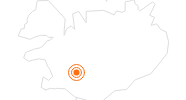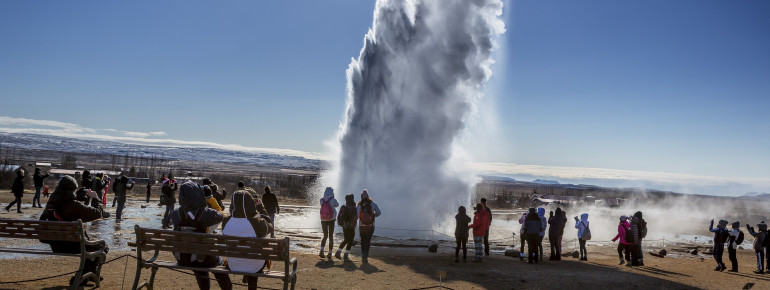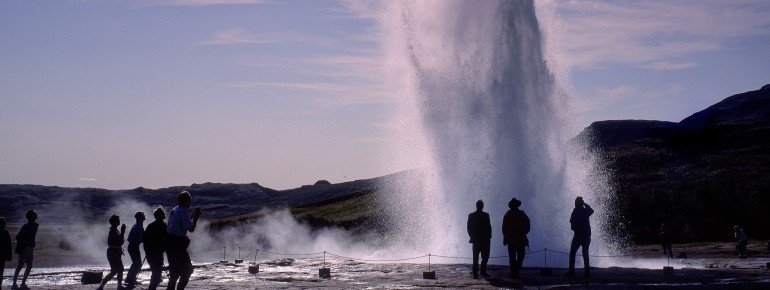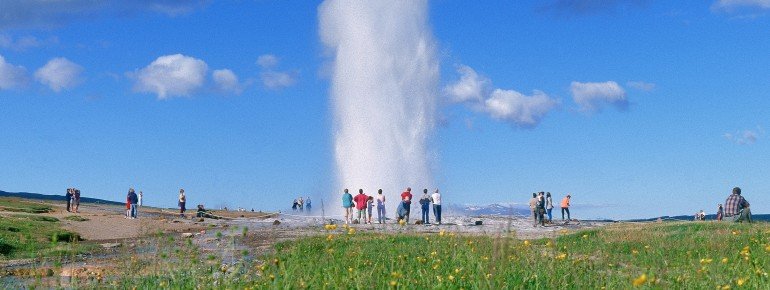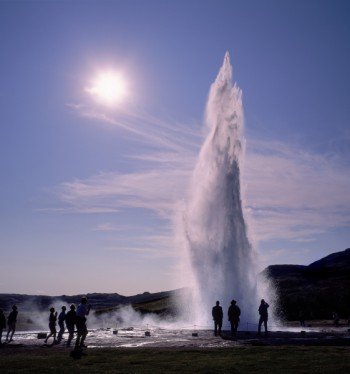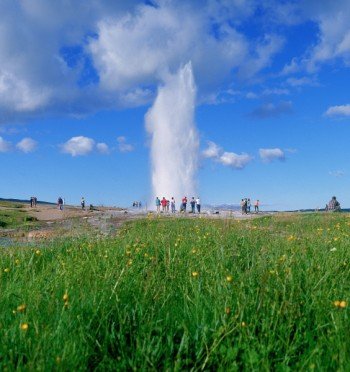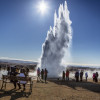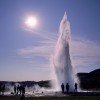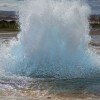Contents
Description
The Great Geyser
One of Iceland's greatest natural monuments and part of the famous “Golden Circle” is the Great Geyser, also known as Stori Geyser. It is located in the Haukadalur hot spring area in the southwestern part of Iceland. The geyser has been active only very rarely in modern times. According to various sources, it spewed water in 1916 and 1935, shooting a spectacular jet of hot water and steam up to 80 meters into the air. After its brief eruptions, the geyser immediately became inactive again. Since then, its tranquility has been disturbed several times when carbolic soap powder was poured into its bubbling, approximately 19-meter-wide and 20-meter-deep opening in an attempt to awaken it. However, all attempts failed. The reason given for its inactivity is the accumulation of stones and objects inside it, which have been thrown in by thousands of tourists over the years. Although this certainly damages the geyser, it cannot be the only reason for its inactivity. The Great Geyser was one of the most famous geysers in the world, along with those in Yellowstone Park, New Zealand, and northern Iceland.
Strokkur Geyser
The main attraction in the area is now the Strokkur Geyser, another geyser located about 100 meters south of the Great Geyser. Its name means “butter churn” in English and comes from the shape of the geyser. The Strokkur geyser erupts at regular intervals of about every 10 minutes. Visitors are then impressed by the white column of boiling water that the geyser shoots up to 30 meters into the air.
The Haukadalur geothermal area
Although the Great Geyser itself is more or less inactive, the surrounding area is geothermally very active. This means that visitors can also discover other geothermal formations typical of such areas: basins with bubbling, unusually colored, sulfur-rich mud, hissing, steaming openings in the ground, hot and cold springs, warm currents, and simple, primitive plants – all of which can be found in the area around the famous geysers. In addition to the two large, well-known geysers, there are also about 30 small geysers. Incidentally, the English word “geyser” and the German word ‘Geysir’ are derived from the Icelandic word “geysir”, which means “spring”.
A little to the west is Laugarfjall Mountain, which offers a unique panorama of the geyser area. So if you want a great view of this spectacular natural spectacle, you should climb the small mountain and enjoy the view.
There is also a geyser museum, a geyser golf course, and a hotel nearby. The Blesi hot spring, another popular attraction, is also located in the geothermal area. Not far away is the famous Gullfoss waterfall, which is definitely worth a visit.
Historical Information
It is not known exactly when the Great Geyser was formed. However, it is believed that it was awakened around the end of the 13th century, when a series of severe earthquakes and the devastating eruption of Mt. Hekla shook the Haukadalur region, the geothermal valley where the geysers are located. Studies of the rock material around the geyser have shown that it had probably been active for around 10,000 years prior to this. According to various sources, until the beginning of the 19th century, the Great Geyser erupted regularly every three hours and spewed water. From then on, the intervals between eruptions became longer and longer until it finally stopped spouting in 1916. Whether its dormancy is permanent or only temporary, no one knows. The formation and eruptions of the Strokkur geyser are also influenced by earthquakes in the region.
Interesting facts
- Great Geysir and Strokkur Geyser is among the 3 best rated Tourist Attractions on Iceland.
How to get there
The Haukadalur geothermal area is located in southwest Iceland. Road 35, Biskupstungnabraut, leads directly to the geysers. It is about 105 kilometers from Reykjavík. The nearest large town is Laugarvatn. From there, it is about 30 kilometers. Simply follow Road 37 to the intersection with Route 35 and then drive north along it to the geyser. As the geothermal area is part of the Gullni hringurinn (Golden Circle), it is advisable to visit the geysers on one of the many day tours on offer.
